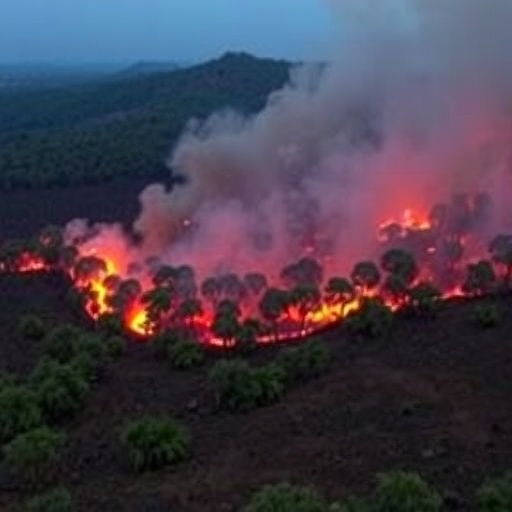In recent years, the Miombo Woodlands of Tanzania have become a focal point for environmental research due to their unique ecological characteristics and the critical role they play in the region’s biodiversity. The study conducted by Baltazary, I.S., Malila, B.P., and Lyimo, P.J., sheds light on the spatial relationships between land use and land cover changes, ecological fires, and their implications for sustainable management and conservation in this distinct ecosystem. The findings from their study present a crucial insight into how these factors interconnect, influencing not only the local ecology but also the livelihoods of communities depending on these resources.
Miombo Woodlands, characterized by a variety of tree species, serve as essential carbon sinks, contribute to the local climate, and provide resources for both wildlife and human communities. However, this intricate ecosystem faces numerous challenges due to anthropogenic pressures, including agricultural expansion, deforestation, and climate change. Understanding the impacts of these changes on ecological fires—frequent occurrences within these woodlands—is critical for developing effective conservation strategies.
The research highlights the significant increase in land use changes over the past few decades, with a marked shift from natural habitats to cultivated lands. Such transformations can significantly intensify the frequency and intensity of ecological fires, which, while being a natural part of the woodland ecosystem, can lead to unintentional consequences when exacerbated by human activity. The researchers utilized extensive geographical information systems (GIS) and remote sensing technologies to analyze various data layers, providing insights into the spatial dynamics at play.
Statistical analyses performed in the study revealed that the zones most affected by human encroachment corresponded directly with areas that previously experienced frequent ecological fires. The spatial analysis illustrated how these fires do not merely ignite randomly, but instead, their occurrence correlates significantly with anthropogenic influences, showcasing a pattern that could predict future fire events based on ongoing land use changes. Each fire event significantly alters the vegetation cover, which in turn affects soil quality and biodiversity, creating a feedback loop that perpetuates further ecological disruptions.
Furthermore, the study effectively illustrates that understanding the drivers of land use change is key to addressing the complexities of fire management in Miombo Woodlands. It emphasizes the need for an integrative approach that combines ecological knowledge with local community practices aimed at sustainable land management. Traditional agricultural practices might need reevaluating, especially since many rely on slash-and-burn methods that can further contribute to ecological vulnerability.
The implications of the research findings are profound, indicating that effective management strategies must be multi-faceted, incorporating ecological science alongside community input. Sustainable management must not only seek to restore and maintain biodiversity but also to support the locals who depend on these ecosystems for their livelihood. By fostering relationships between local communities and conservation efforts, strategies can be developed that uplift both human welfare and ecological integrity.
The study also advocates for a more profound understanding of the climate dynamics within the region. As climate change continues to influence weather patterns, the resultant variability impacts vegetation growth and fire susceptibility. The Miombo Woodlands, like many ecosystems globally, must adapt to these changes, and the study backs this adaptation with actionable insights. Forecasting methodologies that integrate climate models with potential land use scenarios can aid in predicting future outcomes and guide policy development towards more resilient ecosystems.
Moreover, the research strongly emphasizes the necessity for ongoing monitoring to evaluate the long-term effects of land use changes and fire regimes. The establishment of a comprehensive database that combines historical and real-time data can enhance our understanding of these dynamics, thus supporting policy development and effective management practices. This is particularly crucial in an era marked by rapid environmental changes and biodiversity loss.
As Tanzania moves towards a future that balances development needs with environmental preservation, studies such as this provide critical essential knowledge. They illuminate how integrated land use policies informed by ecological data can foster resilience within the Miombo ecosystem and ensure that the cultural and biological wealth of these woodlands is preserved for future generations.
In conclusion, Baltazary et al.’s research contributes significantly to the understanding of the interplay between land use, ecological fires, and sustainable management in Tanzania’s Miombo Woodlands. Through comprehensive analysis and community-focused strategies, there lies a potential pathway to harmonize human activity with nature’s rhythms, ensuring that this vital ecosystem continues to thrive amidst inevitable change.
Subject of Research: Land use and land cover changes in Tanzania’s Miombo Woodlands and their relationship with ecological fires.
Article Title: Land use and land cover changes spatial relationships with ecological fires and their implications for sustainable management and conservation of Tanzania’s Miombo Woodlands.
Article References:
Baltazary, I.S., Malila, B.P., Lyimo, P.J. et al. Land use and land cover changes spatial relationships with ecological fires and their implications for sustainable management and conservation of Tanzania’s Miombo Woodlands.
Discov. For. 1, 23 (2025). https://doi.org/10.1007/s44415-025-00018-z
Image Credits: AI Generated
DOI: 10.1007/s44415-025-00018-z
Keywords: Miombo Woodlands, land use changes, ecological fires, sustainable management, conservation.




